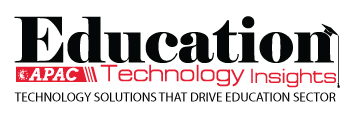THANK YOU FOR SUBSCRIBING
Be first to read the latest tech news, Industry Leader's Insights, and CIO interviews of medium and large enterprises exclusively from Education Technology Insights
Enhancing Learning with Interactive AI Tools
Jason Tan, Director of Higher Education for the SEA & East Asia Region at Pearson
 Jason Tan, Director of Higher Education for the SEA & East Asia Region at Pearson
Jason Tan, Director of Higher Education for the SEA & East Asia Region at PearsonJason Tan is the director of higher education for the SEA & East Asia Region at Pearson. His two decades of leadership in edtech and business development enable him to be proficient in teamwork, budgeting and international business. In an interview with Education Technology Insights APAC, Tan shared his insights about how commercial generative AI is causing setbacks in student learning and engagement. He gave an overview of interactive study tools that allow students to retain what they study.
Key Roles and Responsibilities
I oversee the entire Asia operation in my current role as the director for higher education at Pearson. At Pearson, Asia comprises two regions—East Asia, which includes China, Japan, Korea, Taiwan, Hong Kong and Macau and Southeast Asia, which extends from Singapore to Vietnam, covering about ten countries.
The business is divided into five main streamlines. I am accountable for managing the P&L, focusing on the entire higher education vertical for Asia across diverse markets.
Navigating Challenges in the Edtech Landscape
The edtech landscape is undergoing a lot of disruption due to advancements in AI. Generative AI adapts to the distinctive needs and learning styles of each student, is a catalyst for transformation in the education system and offers a glimpse into the future. However, current commercial AI tools like Chat GPT have the potential to destroy education, as they can transform how instructors teach and how students learn.
In a commercial context, AI is used for Q&A tasks. For example, if you are planning a trip, you can ask ChatGPT to draft a travel plan. In the learning environment, it can lead students to copy-paste the answers and submit them for grades, undermining their learning process and critical thinking capacity.
“We have launched AI study tools embedded with e-textbooks, allowing the students to use generative AI technology within a controlled environment to engage with the content at a deeper level.”
It hinders educator’s abilities to evaluate student performance accurately and leads them to distrust. Students also fear that their genuine work might be mistaken for AI-generated content, which leads to lower grades.
Despite these concerns, students use Gen AI for tasks like summarizing academic materials to save time and learn more efficiently. While AI provides exciting possibilities to the students, there are challenges like accuracy and bias. The effectiveness of these solutions relies on the quality of data it’s trained on.
Opportunities for AI to Enhance Education
The reality is, whether professors like it or not, students continue to use commercial Gen AI to complete their work. One key concern for professors is that AI systems like ChatGPT rely on data harvested from the internet, which is often outdated or biased. We aim to bridge the trust gap between students and teachers by leveraging our credible content. By using AI trained in Pearson's textbooks, they can provide reliable information and support true learning rather than just giving answers.
To solve this, Pearson, a learning company with a vast repository of credible content created by authors, built an AI tool that focuses on learning. This tool helps students understand concepts and prerequisites before tackling questions, ensuring genuine learning takes place. The data source for AI tools in education should come from trustworthy textbooks and academic resources. By using these as the foundation, our AI tools can provide outputs that are reliable and credible, setting us apart from commercial AI solutions. Our goal is not to provide answers but to foster authentic learning by helping students understand concepts and develop critical thinking skills.
Strategies to Enhance Learning and Teaching Experience
We have launched AI study tools embedded with e-textbooks, allowing the students to use generative AI technology within a controlled environment to engage with the content at a deeper level. For instance, students can ask the AI study tool to summarize a specific chapter or to conduct a quiz from specific chapters.
In regions like Asia, where English is not a common language, this tool can help them translate into any Asian language to help the learners understand the concept better.
The AI tools also assist instructors by automating processes like creating study plans, thereby increasing productivity. The primary goal is to help students learn more effectively and efficiently.
Criteria for Selecting Educational Initiatives
We focus on student learning outcomes as a crucial aspect of our educational framework. We ensure that resources and technology are easily accessible to students, which can significantly enhance their learning experience. We can achieve the greatest impact by centering our approach on student success.
Advice for Peers
My advice to other leaders in the education sector is to always put learners at the center of everything you do. Prioritize their needs and outcomes. Even if your business deals with institutions and universities, the end-users are the students. You can develop products that positively impact the community and learners by focusing on learners.
By embracing this learner-centered approach, we can create meaningful and impactful educational experiences that drive personal and professional growth for students worldwide.
Read Also
Empowering Educators through Purposeful, Connected and Transformative Learning
Empowering Students to Lead: A New Vision for Civic Learning
The Director's Playbook: Strategic Digital Transformation in Rual Hyper-Growth Districts
The Art and Architecture of Student Support
From At-Risk to At-Promise: The Language Revolution Higher Education Needs
Teaching Tomorrow: How Western Governors University Is Redefining Teacher Preparation

I agree We use cookies on this website to enhance your user experience. By clicking any link on this page you are giving your consent for us to set cookies. More info






















